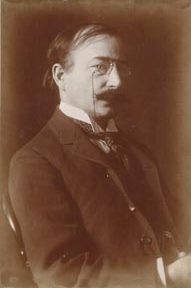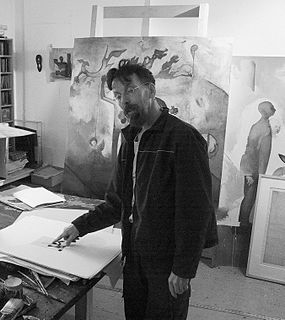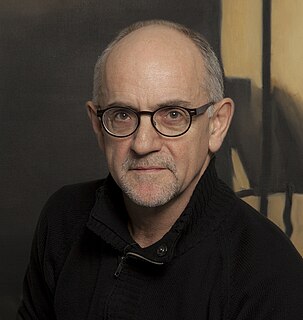Related Research Articles

Marc-Aurèle Fortin was a Québécois painter.
Fernand Toupin was a Québécois abstract painter best known as a member of the avant-garde movement Les Plasticiens. His work is in the collection of the National Gallery of Canada.
Jennifer Lefort is a Canadian artist based in Gatineau, Quebec. Her paintings explore abstraction with their manipulation of colour, narrative and sensation. Her list of solo exhibitions includes shows at the Parisian Laundry in Montreal, the Drabinsky Gallery in Toronto, the Maison de la culture NDG and Montreal and more. She has won many awards for her work including the Royal Bank of Canada Painting Award and the Joseph Plaskett Foundation Award (2005).
Rusdi Genest is a Quebec sculptor known for his symbolic surrealistic art bronzes by lost-wax casting process and for his hand-pressed mural reliefs in fine art papermaking. He was inducted into the Royal Canadian Academy of Arts (RCA) in 2013.
Jennifer Hornyak is a Canadian artist known for her semi-figurative style. Early in her career her scenes of Montreal personalities were exhibited at the 1987 Paris World Exhibition. She is now recognized for her colourful and textured graphic still lifes.

France Jodoin is a Canadian contemporary artist known for her maritime scenes. Painted in a semi-abstract style, her work is a modern interpretation of European Romanticism. Her work is found in Quebec museums, and in galleries in Canada, France and the United States.

Rita Letendre, LL. D. was a Canadian painter, muralist, and printmaker associated with Les Automatistes and the Plasticiens. She was an Officer of the Order of Canada and a recipient of the Governor General's Award.
Valentin Gallery is an art gallery in Quebec. Created in 1934, it was first called "L'Art français" and had its start on Laurier Street in Montreal. Owners Lucienne (1900-1992) and Louis (1890-1956) Lange initially showed works by French artists. By the 1940s they were offering art by Marc-Aurèle Fortin and Philip Surrey. In 1975, Jean-Pierre Valentin purchased the gallery. The gallery moved to its present Sherbrooke Street location later and changed the name to Valentin Gallery.
Nancy Petry is a Canadian artist known for innovation within the field of painting, photography, film and performance art. As one of the first Canadian artists to paint in the style of lyrical abstraction, her work was featured at the Commonwealth Institute, at the Musée d'art contemporain de Montréal and in a National Gallery of Canada touring exhibition. She was also instrumental in establishing the Association des graveurs du Québec and contributed to the success of the Montreal alternative art cooperative, Véhicule Art. In 2015 the "Nancy Petry Award" was instituted.

Kevin Sonmor (1959) is a Canadian artist known for paintings of still lifes, equine and marine scenes. A postmodernist, Sonmor blurs the boundaries between contemporary abstract landscape and historic landscape traditions by creating a visual language which is both representational and symbolic. His work is exhibited in public and private galleries across North America and in Europe.
Susan G. Scott is a Canadian artist known for contemporary figurative painting. Her work is found in national and international public collections including the Canada Council for the Arts, Musée national des beaux-arts du Québec, Musée d'art contemporain de Montréal, Art Gallery of Nova Scotia, Collection du Fonds régional d'art contemporain d’Île-de-France in Paris, Canada - Israel Cultural Foundation in Jerusalem and Houston Baptist University in Texas. She was elected to the Royal Canadian Academy of Arts (RCA) in 2013.

Ghitta Caiserman-Roth was a Canadian painter and printmaker. She was a founder of the Montreal Artist School and her work is in the National Gallery of Canada. Caiserman-Roth was also an associate member of the Royal Canadian Academy and the first painter to receive the Governor General's Award for Visual Media and Art.

Henri Beau was a French-Canadian Impressionist painter. He is noted for Chemin en été, La dispersion des Acadiens, L'arrivée de Champlain à Québec, and Les Noces de Cana. Beau is a largely forgotten artist due to his long absence from Canada. His widow Marie Beau worked towards establishing his reputation as an artist in Canada after his death. He was only recognized as a notable artist decades later, with major retrospectives of his paintings celebrating his career by the Galerie Bernard Desroches in Montréal in 1974, and at the Musée du Québec in Québec City in 1987.

Louis-Pierre Bougie was a Canadian painter and printmaker specialized in engraving and etching. He developed his knowledge of intaglio techniques at Atelier Lacourière-Frélaut in Paris, where he worked for fifteen years, and through travel and study in France, Portugal, Poland, Ireland, Finland, and New York. His work is regularly shown in Canadian, American, and European galleries, and is represented in major public and private collections, notably in Québec and New York. Bougie was considered Québec's foremost engraver for the depth and consistency of his work. He died from pneumonia.
Monique "Mo" Harvey (1950–2001) was a Canadian painter who lived and worked in Montreal, Quebec.

Richard-Max Tremblay is a Canadian artist and photographer. Known for painting and photographic portraits, Tremblay's artistic approach is described as "a dialogue between two media, photography and painting". He is the recipient of the Royal Canadian Academy of Arts' 2015 RCA Trust Award, the 2003 Prix Louis-Comtois, and, as cinematographer of Gugging, the 1996 Special Jury Prize, International Festival of Films on Art and Pedagogy. Tremblay's work is found in the collections of the Montreal Museum of Fine Arts, Musée national des beaux-arts du Québec, Musée d'art contemporain de Montréal, Musée d’art de Joliette, the City of Montreal and the Canada Council for the Arts' Art Bank.
Monique Charbonneau (1928–2014) was a Canadian artist, known for her etchings, lithographs, lyrical wood engravings and gouache paintings. She designed the Canada Post stamp to commemorate the life and work of Quebec poet Emile Nelligan (1879-1941) with the illustration of his poem Le vaisseau d'or. She is one of several artists from Quebec that author Maria Tippett says derived their inspiration from nature.
Sylvia Safdie is a Canadian artist who gathers and utilizes found natural materials in a variety of mediums such as painting, sculpture, drawing, installation, photography and video to explore different themes in her work, calling upon early childhood memories, her Jewish heritage, and her experience of moving from Israel to Canada. She works and lives in Montreal, Québec.

Edmund Alleyn had an art career that underwent many stylistic changes. He explored various styles of painting including abstraction, narrative figuration, technology and pop art, as well as different media. Citics feel that his inability to be categorized marks him as contemporary. Even more important, they say that he helped remove excessive compartmentalization from art practice.
Louis Belzile was one of the main figures of geometric abstraction in painting in Quebec and one of the members of the Plasticiens group in Montreal along with Jauran, Jean-Paul Jérôme and Fernand Toupin.
References
- ↑ "List of members." Royal Canadian Academy for the Arts. Web.
- ↑ Baillargeon, Christiane. "Catherine Farish: Reminiscences: A cartography of intimate spaces." Catherine Farish: Territoires intime. 2006. p.7. Web. p.5.
- 1 2 3 4 "Catherine Farish." Quebec Culture. May-Aug. 2017. p.20. Web. p.12
- 1 2 3 4 5 Lévy, Bernard. "Catherine Farish: Les blessures du temps-Notes biographiques." Vie des arts, vol.48:190. Spring 2003. p.47. Web. p.3
- ↑ "Catherine Farish". www.collections.mnbaq.org. Retrieved 18 January 2020.
- 1 2 3 4 5 Paquet, Bernard. "Catherine Farish." Vie des Arts, vol. 40:166, Spring 1997. p.71. Web. p.3.
- 1 2 Roberge, Gaston, and Madeleine Partous. "Bio." Catherine Farish: Primo pensiero. 1997. pp.13-14. Print.
- 1 2 Lévy, Bernard, André Seleanu and Florentina Lungu. "Les 25 ans de l'atelier circulaire." Vie des arts, vol.51:209. Winter 2007-8. p.27. Web. p.2.
- ↑ Jobin, Michel. "Catherine Farish et Julie Boissonneault décrochent le premier prix de la collection Loto-Québec." Les Nouvelles. 21 Apr. 1992. p.6. Print.
- ↑ Aquin, Stéphane. "Catherine Farish, Figure de style." Voir. 21-27 Apr. 1994. p.25. Print.
- 1 2 Recurt, Elisabeth. "Catherine Farish, Entre matérialité et immatérialité." Parcours arts visuels. May 1994. p.54. Print.
- 1 2 3 "Catherine Farish Bio." Cynthia-Reeves. Web.
- 1 2 "Catherine Farish: The Persimmon Prints." Spheris Gallery. 2002. Print. p.1. Web. p.2.
- ↑ "Trois femmes artistes et leurs oeuvres sur papier à Tournai et à Bruxelles." Quebec Ministry of Culture. Mar.-Apr. 1998. Print.
- 1 2 3 Seleanu, André. "Catherine Farish: Transitions." Vie des arts, vol.51:209. Winter 2007-8. p.31. Web. p.6.
- ↑ Lévy, Bernard. "Catherine Farish: Les blessures du temps." Vie des arts, vol.48:190. Spring 2003. pp.46-50. Web. pp.1-6.
- ↑ Enright, Robert. "Legend-Maker Catherine Farish and the Piano Roll Project." Catherine Farish Notes. 2011. pp.11-13. Web. pp.6-7.
- ↑ "Catherine Farish Blue." Galerie Simon Blais. 2015. Web.
- 1 2 "Catherine Farish." Cynthia-Reeves. Exhibition catalogue 2015. Web.
- ↑ "Pulse 2016." artsy.net. Web.
- 1 2 Burnett, Henny. "Visiting Catherine Farish's Studio." Blog, 22 Oct. 2016. Web.
- 1 2 Roberge, Gaston, and Madeleine Partous. Catherine Farish: Primo pensiero. 1997. p.8. Print.
- ↑ Catherine Farish: The Persimmon Prints. Spheris Gallery. 2002. Inside front cover. Web. p.2
- ↑ Enright, Robert. "Legend-Maker Catherine Farish and the Piano Roll Project." p.11. Web. p.6.
- ↑ Lévy, Bernard. "Catherine Farish: Les blessures du temps." p.46. Web. p.2.
- ↑ Grande, John K. "Volte-face". Plein-Sud. 1996. Print. Web.
- ↑ Lévy, Bernard. "Catherine Farish: Les blessures du temps." p.50. Web. p.6
- 1 2 Kozinska, Dorota. "Catherine Farish: New Paper Works." Vie des arts, vol. 50:202. Spring 2006. p.72. Web. p.4.
- 1 2 Stockwell, Craig. "Reviews: New Hampshire - Catherine Farish." Art New England. Oct.-Nov. 2007. p.5. Print.
- ↑ Barnard, Elissa. "At the Galleries." The Halifax Chronicle Herald. 2 Mar. 2003. p.B2. Print.
- ↑ Enright, Robert. "Legend-Maker Catherine Farish and the Piano Roll Project." p.13. Web. p.7.
- 1 2 "Catherine Farish." Ballinglen workshops. Web.
- ↑ Roberge, Gaston, and Madeleine Partous. "Primo pensiero." p.13. Print.
- ↑ "Hibernus Description." Royal Canadian Academy of Arts. Web.
- ↑ Farish, Catherine. "RCA Member Travelogue." RCA News. Spring 2011. Web.
- ↑ "Visiting Artist Program." St. Michael's Printshop. Web.
- ↑ "Faculty: Catherine Farish." Two Rivers Printmaking Studio. Web.
- 1 2 "Artist: Catherine Farish." Galerie Simon Blais. Web.